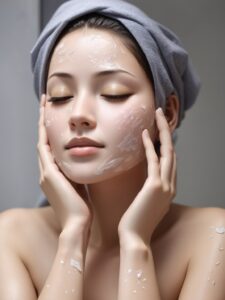Preventing skin diseases involves adopting healthy habits and practices to protect your skin from various environmental, microbial, and genetic factors. Here are five effective ways to help prevent skin diseases:
-
Regular and Gentle Cleansing:
- Use a mild, pH-balanced cleanser suitable for your skin type. Avoid harsh soaps and excessive scrubbing, as they can strip the skin’s natural oils and disrupt its protective barrier.
- Cleanse your skin twice a day, especially after sweating or exposure to pollutants.
-
Protection from UV Radiation:
- Wear broad-spectrum sunscreen with at least SPF 30 daily, even on cloudy days. Reapply every two hours or more frequently if swimming or sweating.
- Seek shade during peak sun hours (10 a.m. to 4 p.m.) and wear protective clothing like wide-brimmed hats, long sleeves, and sunglasses.
-
Balanced Diet and Hydration:
- Eat a well-balanced diet rich in fruits, vegetables, whole grains, lean proteins, and healthy fats. These provide essential nutrients that support skin health.
- Stay hydrated by drinking enough water to keep your skin moisturized from the inside out.
-
Avoiding Irritants and Allergens:
- Identify and avoid substances that irritate or trigger allergies for your skin. This may include certain chemicals, fragrances, detergents, or specific plants.
- If you have known allergies or sensitivities, choose hypoallergenic or fragrance-free products.
-
Maintain a Consistent Skincare Routine:
- Establish a routine that includes cleansing, moisturizing, and protection from UV rays. This consistency helps maintain the skin’s natural balance and keeps it healthy.
- Use products tailored to your specific skin type and concerns.
Additionally, it’s important to:
-
Manage Stress:
- High stress levels can exacerbate certain skin conditions. Practice relaxation techniques such as meditation, deep breathing exercises, or yoga to help manage stress.
-
Regular Check-ups and Early Intervention:
- Regularly check your skin for any unusual moles, growths, or changes in existing spots. Seek prompt medical attention if you notice anything suspicious.
Remember that if you have a specific skin condition or medical history, it’s always best to consult a dermatologist for personalized advice and treatment options. These general practices can contribute to overall skin health and help prevent many common skin diseases, but individual circumstances may require tailored approaches.
Types of Skin Diseases and Symptoms
 There are numerous types of skin diseases, each with its own set of symptoms and characteristics. Here are some common skin conditions along with their typical symptoms:
There are numerous types of skin diseases, each with its own set of symptoms and characteristics. Here are some common skin conditions along with their typical symptoms:
- Acne:
- Symptoms: Pimples, whiteheads, blackheads, cysts, and nodules on the face, neck, chest, back, and shoulders. In severe cases, it can lead to scarring.
- Eczema (Dermatitis):
- Symptoms: Red, itchy, dry, and flaky patches of skin. It can sometimes be accompanied by swelling, blisters, or oozing of fluid.
- Psoriasis:
- Symptoms: Thick, red patches of skin covered with silvery scales. It can occur anywhere on the body and may be itchy or painful.
- Rosacea:
- Symptoms: Persistent redness of the face, particularly on the cheeks, nose, forehead, and chin. It may also lead to visible blood vessels, bumps, and sometimes eye irritation.
- Skin Cancer:
- Symptoms: This can vary depending on the type of skin cancer, but may include changes in the appearance of moles (irregular borders, color changes, growth), the development of new growths, or sores that don’t heal.
- Fungal Infections (e.g., Ringworm, Athlete’s Foot):
- Symptoms: Red, itchy, and sometimes circular rashes. They may have a raised, scaly border and clear in the center.
- Contact Dermatitis:
- Symptoms: Red, itchy, and sometimes blistering rash that occurs after contact with an irritant (irritant contact dermatitis) or allergen (allergic contact dermatitis).
- Hives (Urticaria):
- Symptoms: Raised, itchy welts on the skin that can vary in size and shape. They may be red or white and often appear suddenly.
- Vitiligo:
- Symptoms: Loss of skin color, leading to white patches on the skin. These can occur anywhere on the body and may gradually enlarge.
- Herpes (Simplex or Zoster):
- Symptoms: Painful, fluid-filled blisters on or around the mouth (HSV-1) or genital area (HSV-2). Shingles (caused by the varicella-zoster virus) leads to a painful rash along a nerve path.
- Impetigo:
- Symptoms: Red sores that quickly rupture, ooze fluid, and form a honey-colored crust. It often occurs around the mouth and nose.
- Cellulitis:
- Symptoms: Red, swollen, and tender skin. It may be warm to the touch and can spread rapidly.
- Lupus Erythematosus:
- Symptoms: Varies widely but may include a butterfly-shaped rash on the face, joint pain, and fatigue. It can also affect internal organs.
- Ichthyosis:
- Symptoms: Dry, thickened, scaly skin that may resemble fish scales.
- Melasma:
- Symptoms: Brown or gray-brown patches on the skin, commonly on the face, particularly during pregnancy or with hormonal changes.
It’s important to note that some skin conditions can have overlapping symptoms, and a proper diagnosis should be made by a qualified healthcare professional, typically a dermatologist. If you suspect you have a skin condition, seek medical advice for accurate diagnosis and appropriate treatment.
